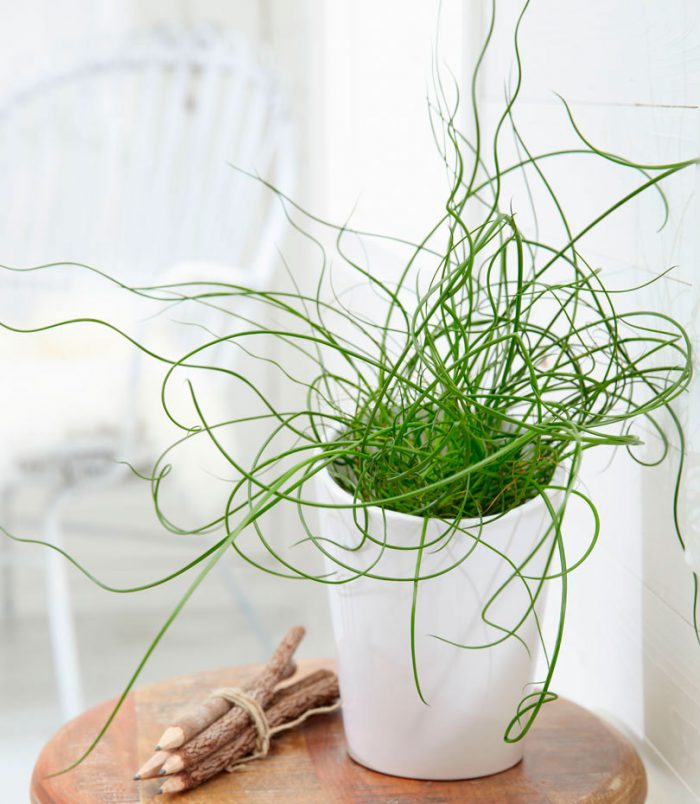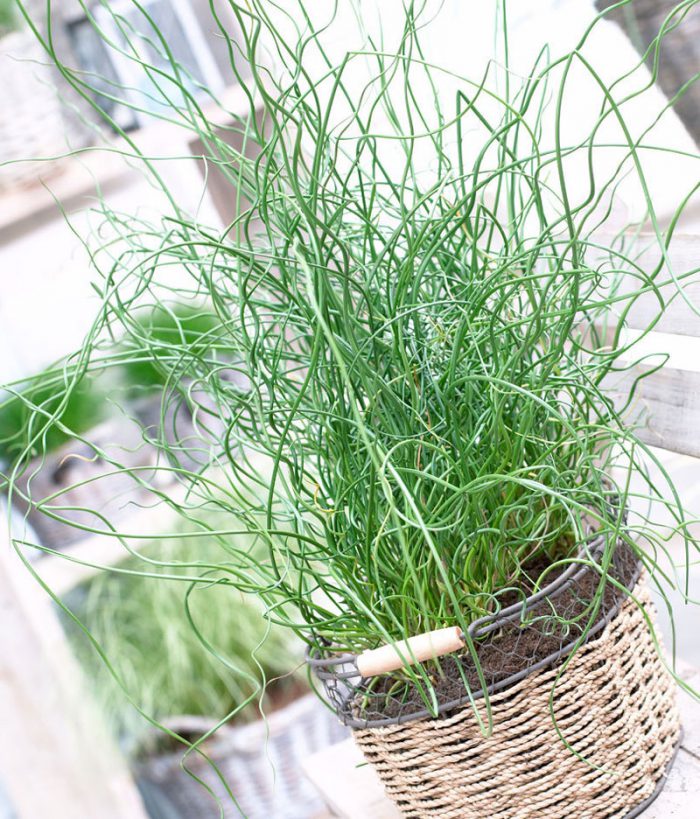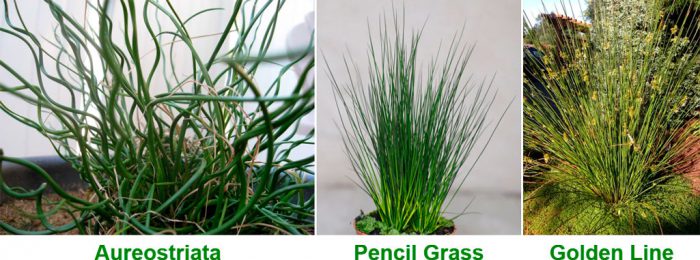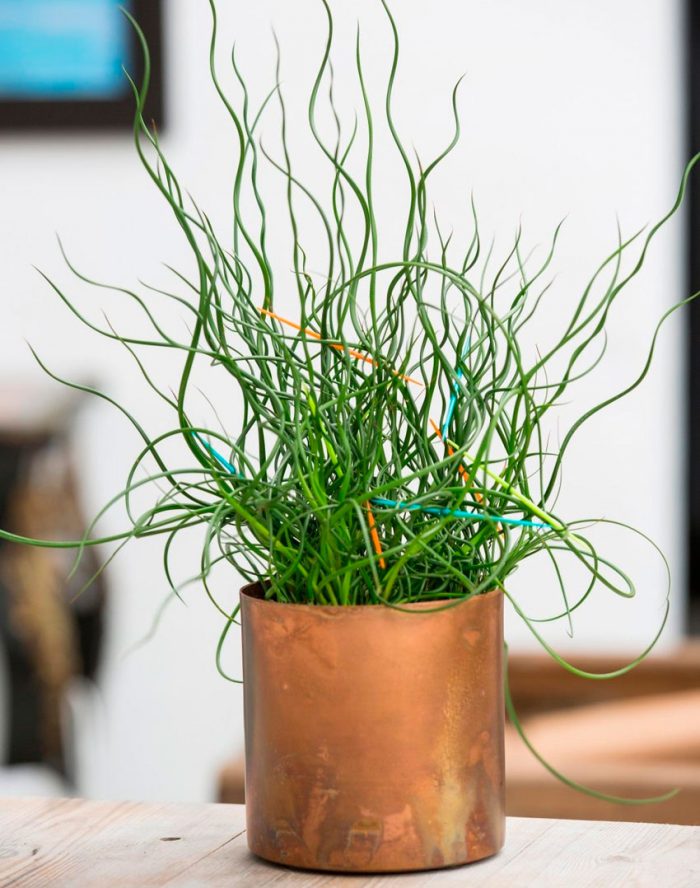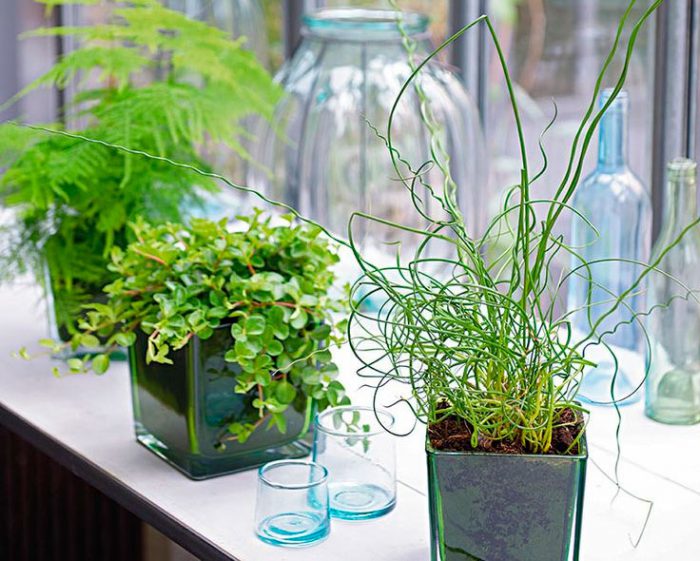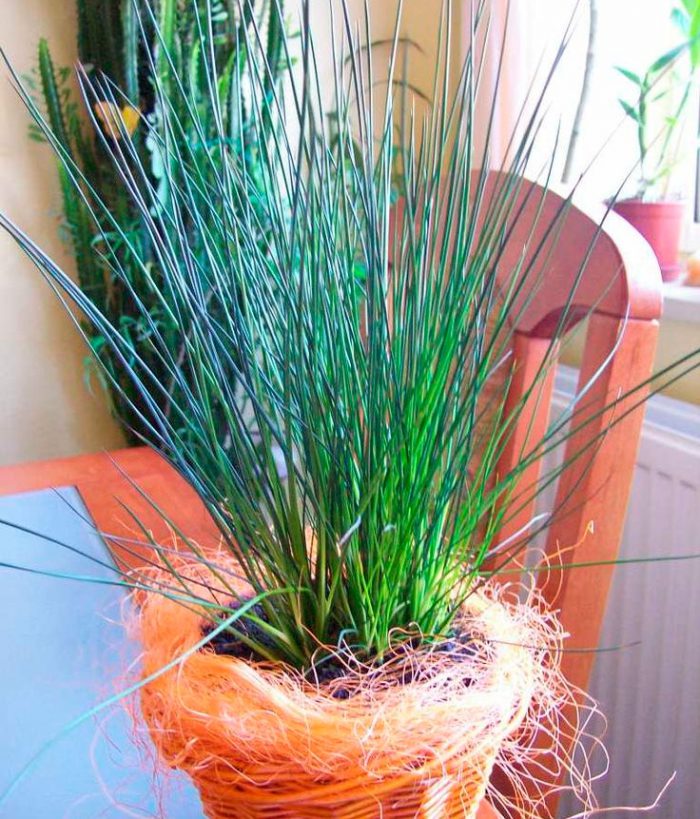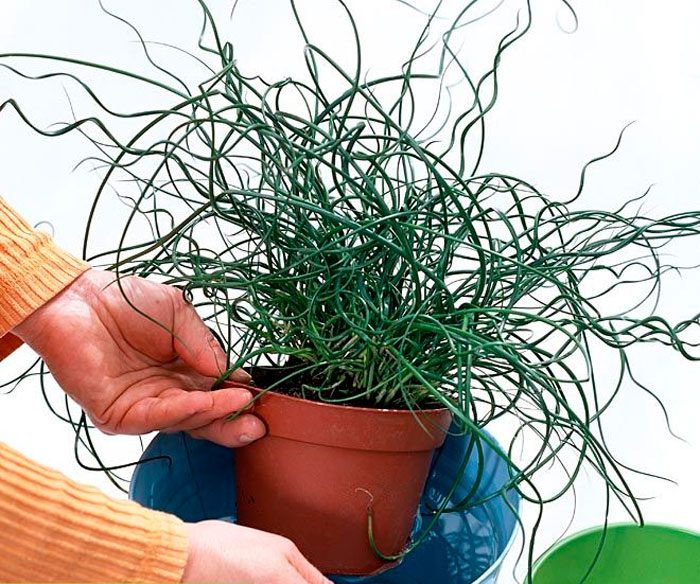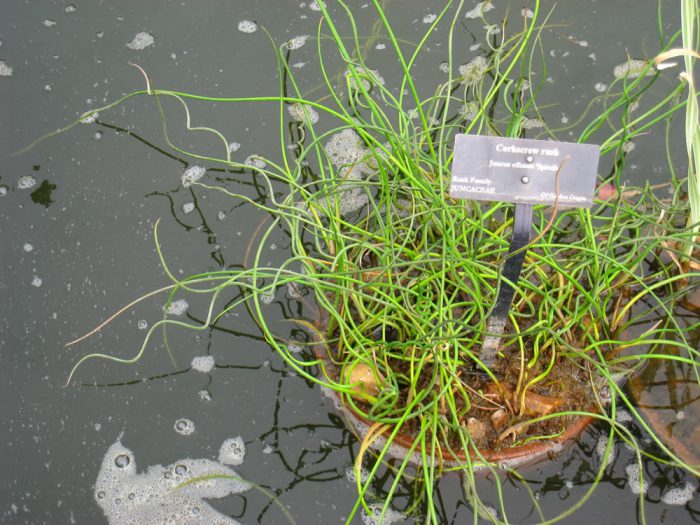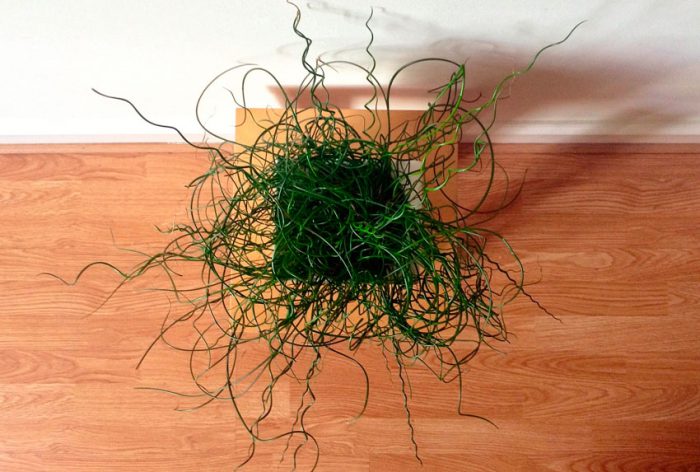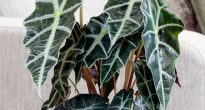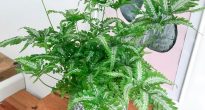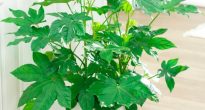A plant such as junkus or sitnik is something new and not quite usual for interior design. Information about such a plant is not even included in a large number of encyclopedias. However, their appearance is so unusual and effective that once you see it live, you will definitely not forget such a flower. Unusual stems, twisted in a spiral, as well as long and thin shoots-twigs - this is the main distinguishing feature of the rump, which is also called junkus. Such a plant is incredibly moisture-loving, but growing it will not cause much trouble. This spectacular flower undoubtedly deserves more popularity.
Features of the sitnik (junkus)
Among the plants grown indoors, there are a large number of flowers that are used in landscape design. However, most of them are annuals or abundantly flowering shrubs. There are relatively few decorative deciduous crops among them. And there are even fewer exotic and very original plants among them. Sitnik refers to just such colors. In nature, it grows in reservoirs, and in the garden it is decorated with wet garden beds or various water bodies. This plant is rarely grown indoors. However, due to its unique appearance, it attracts the attention of a large number of designers and florists. This plant has such an unusual appearance that it overshadows even the spectacular sansevieria.
Sitnik is also called Juncus or Juncus. It is directly related to the family Juncaceae. Sitnik is translated from Latin as “weave”. The fact is that since ancient times, the stems of such a plant have been widely used for weaving shoes, baskets, and also mats. This perennial is a short-rhizome cereal. It is not frost-resistant, but it loves moisture very much. When grown at home, these plants reach a height of no more than 40-50 centimeters. On the basis of tough thin shoots, brownish scaly sheaths are worn. Like other cereals, this plant also blooms. The inflorescences bear small flowers that look very unusual and spectacular. They are painted in off-white or light brown color and are part of panicle inflorescences, which have crowded branches that stand out for their asymmetry.The inflorescences lean slightly to the side of the bract, which looks like a continuation of the shoot.
At home, only 1 species of this plant is grown. However, such a flower has a unique, but rather incredible appearance, and no doubt attracts special attention. At home, they grow only a species called broadsweet (Juncus effusus). And as a rule, only 1 variety of this type of rump is grown. It is such a plant that has spectacular twisted stems, on which there is not a single leaf.
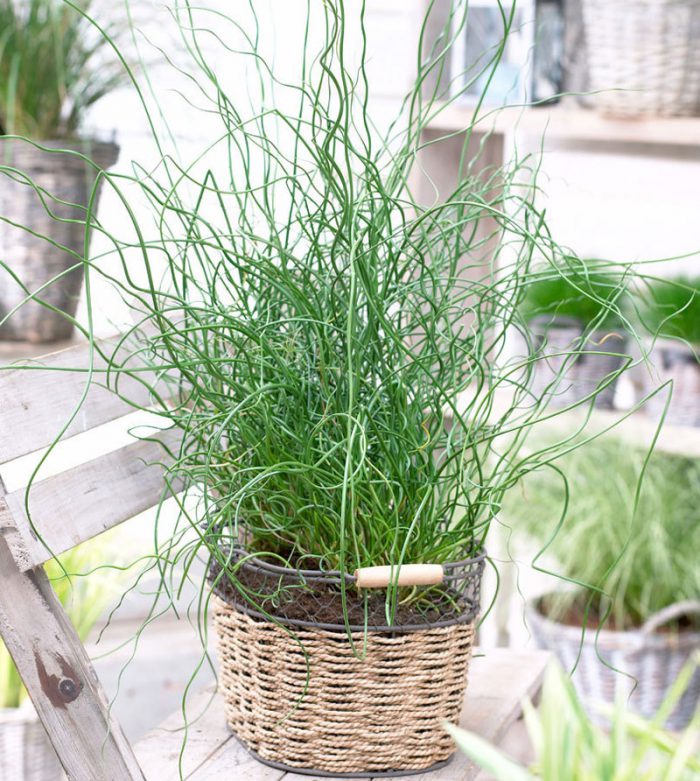
The spreading rush "Spiralis" (Juncus effusus "Spiralis") is most often called simply the spiral rush. By the way, it is often put up for sale in the store under that name. It belongs to cereal grasses. The rump is capable of producing a fairly spreading and dense turf, consisting of long thin leafless shoots. The stems of such a flower have a very unusual shape. So, they are twisted in a spiral so bizarrely that it may seem as if they were specially wound by hand.
However, in indoor conditions, not only the species with spiral stems is grown. For example, they also grow the "Blonde Ambition" variety. It differs from the previous variety in that the stems have a golden straw color, and their turns are large. There are also straight-growing varieties in indoor conditions, which also look quite unusual and impressive. For example:
- Bulge "Aureostriata" - this variety has strong shoots with a variegated color. So, along their entire length, there are areas of green, as well as yellow.
- The “Pencil Grass” (Pencil Grass) - has straight and rather thick stems, which create a sod more like a large grass or a bundle of green brushwood. Hollow, shiny leaves are dark green in color and grow in a fairly dense turf. Their height can exceed 50 centimeters.
- Sitnik “Golden Line” - the stems of this variety have a golden color. At first glance, this plant may seem artificial, the hollow, thin and almost perfectly straight shoots look so unusual.
It is quite possible to use such plants to decorate rooms with an extravagant and daring interior design. Sitnik can be an excellent replacement for a sculpture or some rather voluminous decorative element. They can be grown in living rooms and bathrooms and greenhouses. This plant can be used as a horizontal space divider when dividing it into zones. Unique and very sophisticated curves and lines can visually expand the room.
Caring for junkus or rump at home
Juncus is an extremely unusual and unusual plant. It is not very difficult to grow such a flower, however, in order for it to grow and develop normally, one very important nuance should be taken into account - the sitnik needs a very large amount of moisture. So, those who decide to grow it indoors will have to learn how to create and also maintain practically marsh conditions. If you are not going to grow a rump on a paludarium, then you have to learn all the rules for caring for such a cereal, which are non-standard and rather unusual. In this regard, it is recommended to take up the cultivation of such a plant in indoor conditions only for those who are ready to spend a lot of time and effort to provide it with the necessary conditions. Therefore, before acquiring a sitnik, you should think carefully.
Illumination
This plant is very fond of light, so at home you should choose a well-lit place for it. You should ask the seller about the level of lighting a particular copy needs at the time of purchase.The fact is that in some cases this cereal is specially taught to penumbra, thus trying to expand the possibilities of its use when decorating a room. It should be noted that almost all plants belonging to this genus need bright lighting, but at the same time it must be diffused. It must be remembered that the flower must be protected from bright scorching direct sunlight. Accustomed to very bright and intense light, junkus will feel fine even in the southern part of the room.
Supplementary lighting has a beneficial effect on the growth and development of a plant, which, by the way, can be grown without natural light, completely replacing it with artificial light. To place such a flower, it is recommended to choose an east or west orientation window. If the room is quite light, then the sitnik may well be placed at some distance from the window opening.
Temperature
When grown at home, the rump needs warmth. Best of all, such a cereal plant feels in a room where the temperature is quite high, or rather more than 24 degrees. But it will also feel quite comfortable in a room where the temperature does not drop below 18 degrees. It should be remembered that the room where such a flower is located should not be colder than 15 degrees. In winter, you should not lower the air temperature in the room. The fact is that a rather sharp decrease in temperature can lead to the dormancy of the junkus. So, the plant will stop growing, and its shoots will begin to dry out actively. The dormant period will end with the onset of the spring months. In the event that the plant is already old enough, it is recommended to arrange a dormant period every year, however, it should be rather short. So, 2 weeks before the beginning of the spring period, the temperature in the room should be lowered to 16-18 degrees. If the sitnik is still young enough, then it is not necessary to arrange periods of rest for him.
It should be remembered that a sharp change in temperature, as well as drafts, have an extremely negative effect on such a cereal. It is especially necessary to ensure that there is no strong cooling of the soil in the flower pot. In order to avoid cooling the soil, the container with the rump should be placed on a special stand. In the warm season, such a plant, if desired, can be transferred to the balcony, which must be glazed, or it can be placed in a well-protected area of the garden or terrace.
How to water
The most suitable watering regime for junkus is quite simple. For this flower, the classic watering scheme is not suitable (after a certain period of time). So for normal development and growth, the water in the pot must constantly be at approximately the same level. So, the water should be slightly higher than the drainage layer located at the bottom of the pot. When growing in double containers, tall trays, the liquid level should be constantly maintained so that it does not drop below 8-10 centimeters. This plant is ideal for hydroponic cultivation, and you can also use special flower pots with automatic watering for planting it. In such containers, you need to add liquid more often. You should not allow the substrate to dry out even a little, because it is destructive for the rump, not to mention the complete drying of the earthy coma. During watering, it is quite possible to pour the liquid directly into the flower pot, and it can also be poured into the tray.
This cereal should be watered only with soft and well-settled water. It is better if such water is at room temperature.
Air humidity
Juncus needs very high air humidity. In the case when the humidity in the room does not exceed 50 percent, as well as if heating devices are working, it is very often necessary to moisten the plant itself from the sprayer.However, as a rule, if you water the rump quite often or maintain the required level of liquid in the pot, then this can increase the humidity of the air to those values that are so necessary for this plant for normal growth. In the same case, when the room has too dry air and the liquid evaporating from the pot is clearly not enough, to maintain optimal humidity, you can resort to a proven and reliable method - moisten the plant from a sprayer and do this as often as possible. However, you need to spray water not directly on the plant, but somewhat moving away from it. The result should be a kind of fog. It is easiest to increase the humidity with the help of special purchased or homemade humidifiers, but the usual measures are quite enough for the normal well-being of the flower. In the case when the room is constantly dry air, you need to put containers with water, an aquarium, indoor fountain, etc.
Juncus not only loves moisture very much, but is himself considered an excellent air humidifier. Placing it in a room is like, for example, a home fountain. This plant has a very beneficial effect on the microclimate of the room in which it is located.
Fertilizer
It should be fed during the period of intensive growth (in the spring-summer period) 2 times a month. To do this, use universal fertilizers or fertilizers for decorative deciduous plants. During the dormant period, the flower is not fed. If the rump continues to grow in the winter, then it must also be fed, but at the same time ½ part of the dose recommended on the package should be used.
Pruning features
The rump does not need formative pruning. However, such a plant will need systematic procedures:
- in spiral species, erect stems should be cut, and in variegated ones - green (to the base);
- you need to remove branches that are damaged or dry;
- if the tips of the stems dry out, then they should be carefully cut off.
The choice of a pot, features of transplantation and soil mixture
For cultivation, both paludariums and ordinary containers are suitable, selected taking into account the fact that the rump needs conditions as close as possible to marsh. It can be grown hydroponically using a pot with a liquid reservoir. Also, a double pot is suitable for growing, the required liquid level in it is quite easy to maintain. In this plant, the root system is not only superficial fibrous, it also grows thin filamentous lateral roots. In this regard, a suitable container must be sufficiently narrow and high. A tight pot is not suitable for planting. The new pot should be 5 centimeters larger than the old one.
A suitable substrate should be acidic, loose, light and absorb moisture well enough. Purchased soil for paludariums or aquatic plants is suitable. To prepare the soil mixture, combine the garden (universal) soil with moss, bog peat, perlite, sand, pebbles or other leavening agents.
You need to transplant if necessary. So, for example, if the pot becomes small, with a significant thinning of the stems in the winter or wilting - in the summer. The root system grows intensively, old roots die off, constant high humidity is observed - this is an ideal environment for the appearance of rot or soil acidification. Therefore, experts advise transplanting once a year. She does not harm Sitnik at all. So, you can even remove all the old soil and inspect the root system. The plant recovers well during a forced transplant (if possible, it is postponed until the onset of spring).
A thick, coarsely fragmented drainage layer should be made at the bottom (expanded clay is best suited for this purpose).When you remove the flower from the pot, it is necessary to cut off any spoiled stems, and also conduct a thorough examination of the roots. The rump should be left at the same depth as in the previous container. At the very end, do not forget to mulch the substrate, for example, with decorative stone soil or expanded clay. This will protect against excessive loss of moisture and will not allow the top layer of the substrate to dry out too much.
Diseases and pests
Resistant to pests and diseases. If at least one insect was noticed, then you need to treat the flower only 1 time with a fungicide or insecticide. If rot has appeared on the roots, then it is necessary to transplant the rump as soon as possible.
Possible problems
The stems will dry out and die if the plant is in a room with excessively dry or cold air. In winter, the death of shoots is considered preparation for the dormant period, and in the summer, the formation of rot on the root system is to blame.
If the rump does not get light, then its shoots will become faded.
Reproduction methods
At home, only varietal plants are grown, which reproduce only in a vegetative way. So, overgrown bushes during the transplantation process can be divided into several parts. It should be noted that each division must have a powerful bunch of roots and at least 10 pieces of strong shoots.

